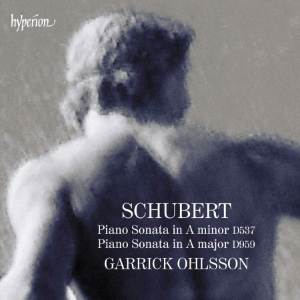
Franz Schubert (1797-1828)
Piano Sonata in A minor D537 (1817)
Piano Sonata in A major D959 (1828)
Garrick Ohlsson (piano)
rec. 2021, St Silas the Martyr, Kentish Town, London
Hyperion CDA68398 [66]
Despite his fame and the longevity of his career, I confess to having been unfamiliar with Garrick Ohlsson. My exposure to Schubert’s piano sonatas has been through a wide variety of famous pianists in a host of celebrated recordings: Feltsman, Kempff, Klien, Perahia, Pollini and Tirimo have all been my route into these sonatas, but somehow I have missed Ohlsson. It happens; all listeners have their lacunae.
My comparison for the earlier work, No. 4 – Schubert’s first completed sonata – was with Klien and Feltsman. I find both to have more lilt and lift, more varied phrasing and dynamics than Ohlsson, and while the sound for Klien is obviously of a slightly duller vintage, I also prefer the brighter sound the Nimbus engineers gave Feltsman; Hyperion’s sound is tubbier. Ohlsson takes a repeat in the first movement which the other two pianists do not, extending its duration by nearly three minutes; the question of the inclusion of repeats is always a matter of taste and many will agree with Brendel that it is not important; personally, in music of this – admittedly deceptive – insouciant nature, its “simple” opening theme written in a bouncy 6/8 time when Schubert was only twenty, I can dispense with it, but I think by including it Ohlsson is choosing to emphasise more the darker tone of its tragic middle section.
Similarly, while Klien’s and Feltsman’s tempi in all three movements are virtually the same, Ohlsson takes a more sombre and leisurely stance to the middle movement Allegretto, contrasting strongly with Klien’s perkier manner. The same is true of the Allegro vivace, which emerges a brighter and lighter in Klien’s hands.
Such differences are, like the repeats, a matter of taste not necessarily qualitative; what matters is that an artist have a coherent conception which is effectively communicated to the listener. I cannot for a moment fault Ohlsson’s aesthetic or technique, only say that my preference is for a slightly lighter approach and a brighter recorded sound.
I note that Ohlsson’s timings for D959, No. 20, are similar to those of favourite recordings by Arcadi Volodos (review) and Feltsman (review), although both Ohlsson and Feltsman are faster in the Andantino. All three, however are somewhat slower than Pollini and Perahia, whose more propulsive recordings are understandably the go-to favourites for many. Kempff, Klien and Tirimo (review) are very good but they all omit the repeats. I like all these recordings; they all have something unique and powerful to say about this extraordinary work and Tirimo’s part of a valuable set which includes completions of the unfinished works.
Ohlsson’s first notes are arresting but I find Volodos marginally grander in that defiant, opening statement and more delicate in his execution of the diffident reply and I think Volodos’ gradation and variety of dynamics, especially in falling figures such as that at 3:19, are slightly more subtle. It may be that some will prefer Ohlsson’s more assertive way with Schubert’s turbulent music and Volodos is too smooth and insufficiently percussive; again, this is a matter of personal response. The wonderful arpeggiated conclusion to this movement is beautifully played – but as beautifully as Volodos? Not quite – and he certainly does not achieve the magical hush Volodos creates in the opening of the Andantino; the speed is right but it is simply too loud. The stormy central section, however, is mightily impressive; like Feltsman, Ohlsson’s playing is constantly suggestive of sublimated passion. The Scherzo waltz is almost absurdly cheerful after such Angst but it is deftly and charmingly played here. The metanoia from the agonised and doom-laden introspection of the first two movements through the Scherzo to the rippling insouciance of the finale is neatly negotiated and we hear Schubert hymning himself to an early death on the wings of song a mere two months after this sonata was composed – but not before the central section recalls and recreates earthly struggle. The fluidity and poetry of Ohlsson’s playing are a joy. I sometimes think that what sounds like the undue protraction of the last movement is symbolic of Schubert’s unwillingness to let go of his hold on life while still so young, and Ohlsson catches the mood of perseveration inherent in those desperate, breathless, cascading roulades and restless, left-hand repetitions.
Excellent sound enhances the virtuosity of Ohlsson’s playing, but again, I marginally prefer the extra sonority of Volodos’ – piano? – or the sound provided by his engineers? I don’t know – and Feltsman’s sound is a little clangourous by comparison, so for me Volodos just wins out in engineering terms, too. Nonetheless, this new release of two piano sonatas spanning Schubert’s entire output in the genre is a fine achievement.
Ralph Moore
Help us financially by purchasing from




















